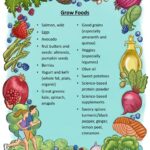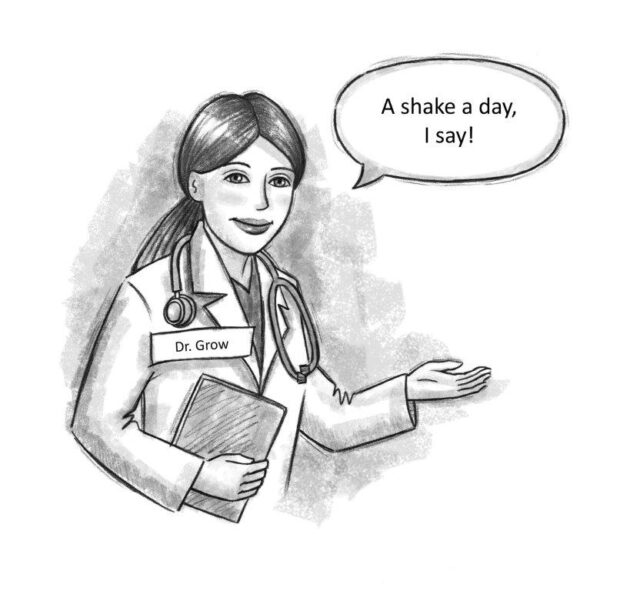Kids are often passionate, and sensitive, about how “tall” they are. I remember each of our kids getting excited with each incremental pencil mark up our kitchen wall. While it is true that a person’s height is primarily determined by genetics (i.e., the height of their parents), the new sciences of nutrigenetics and epigenetics reveal that nutrition and lifestyle choices may also play an important role right alongside parental genes. For this reason, I like to use a child’s natural enthusiasm for growing “taller” as an opportunity to educate them (and their parents) on the benefits of a healthy diet and lifestyle.
Now, before we get started, a quick note: It can be easy for a child to develop an unhealthy attitude towards height. For example, it’s not uncommon for children to be bullied because of their height, or they may start measuring their self-worth by how tall they are. After all, what are often the first words a child hears when visiting family? “Wow! Look how big you’ve grown!” We need to be careful not to turn our child’s height into a harmful obsession. Instead, our goal here should be to redirect attention more towards healthy eating and exercise, among other things, and by doing that we can help our children reach their optimal growth potential. We know that inadequate nutrition is a primary cause of stunted growth. So, throughout this article, when I use the phrase “help your child grow taller,” know that I mean doing what you can to make sure your child is growing and developing as healthily as possible.
Over my fifty years in pediatric practice, kids’ growth concerns are one of the top questions I get. Here are the four main factors I see that influence kids’ development and growth (think L.E.A.N.):
L: Lifestyle – How they live influences how they grow.
E: Exercise – Movement builds muscle and bone.
A: Attitude – Excessive worrying can harm development growth.
N: Nutrition – Kids need more “grow foods.”
If you believe your child is not growing optimally, imagine you are visiting the Sears Family Pediatrics office and consulting me: “Dr. Bill, how can I help my kids thrive?” Or, as your kids might hear it, “How can I help my kids grow taller?”
Here’s my five-step action plan to help your child THRIVE.
The 5-Step Action Plan to Help Kids Grow Taller
To reach their optimal growth potential, follow the following 5 steps:
- Plot your child’s growth on a height chart.
- Feed your child “grow foods”.
- Begin the day with a brainy breakfast.
- Raise a grow-food grazer.
- Move more, sit less.
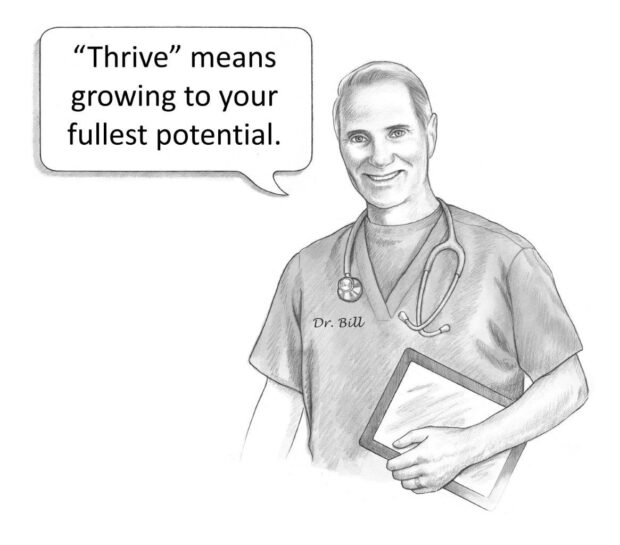
Plot Your Child’s Growth on a Chart
Your child’s place on the growth chart is your starting place for helping your child grow taller. If after giving your child the five steps toward optimal growth you see a jump on the calculator chart, then perhaps your child was not growing optimally but now is, and you have an action plan to continue.
Kids naturally and healthfully come in all sizes and shapes, called “body types.” Some body types tend to be calorie-burners, others are calorie-storers. A way to learn leanness is to compare body types to fruit:
- Bananas are kids who are naturally slender and often tall with little excess body fat. They tend to be calorie-burners.
- Apples are kids of average height and weight and usually more muscular than bananas, yet they tend to be fat-storers, having a tendency to store excess body fat around their middles.
- Pears tend to be short and wider in the hips and thighs. Pears, like apples, tend to store calories more easily than they burn them.
- Yams are naturally big from head to toe.
If your child tends to be an apple, pear, or yam body type, take this as a sign that their diet needs to be focused on mostly healthy grow foods.
| Parents note: Not all kids easily fit into these body types at all ages. Several of our children went through a “chunky” stage from seven to ten years of age which, I believe, was them storing up energy for the growth spurts of the preteen and teenage years when some more chunky body types naturally shift into banana body types. Lean does not mean skinny. It means having the right percentage of body fat for your individual body type. |
Feed Your Child Grow Foods
The second step in our action plan of helping kids grow taller is to feed them “grow foods”.
So what “diet” should your child be on?
Answer: The grow food diet. (“Diet” simply means the way we eat. We’re all on a “diet.”)
<h3>The Fabulous Four Features of Grow Foods for Growing Kids</h3>
So what do I mean when I say “grow foods?”
- Grow foods are nutrient dense. They pack the most nutrients per calorie and volume. Grow foods are rich in the three macronutrients: protein, healthy fats, and healthy carbs. They are also rich in micronutrients like calcium, vitamins, and minerals that help partner with the macronutrients to help your child grow taller, stronger, and leaner.
- Grow foods must be fill-up foods. After eating, you want your child to feel satisfied – not overly full and sluggish nor still hungry. Grow foods high in protein and healthy fats tend to be more filling than carb-rich foods.
- Grow foods should balance blood sugar levels. “Avoid sugar spikes” is my three-word mantra of the year. In recent years the incidence of type II diabetes (the most preventable type) has tripled in children under fourteen years of age. Three reasons: they sit too much, move too little, and eat too many junk foods that cause their blood sugar to spike.
- Grow foods give good gut feelings. If a child’s gut has a sense of “I feel good” after eating a certain food, they are more likely to crave it.
Which food is best to help kids grow taller?
Aim for feeding your child at least a serving of wild salmon three times a week. There is no other food on the planet that contains the most grow foods in the smallest number of calories and volume than a chunk of wild salmon.
Per 6-oz serving of Wild Alaskan Salmon: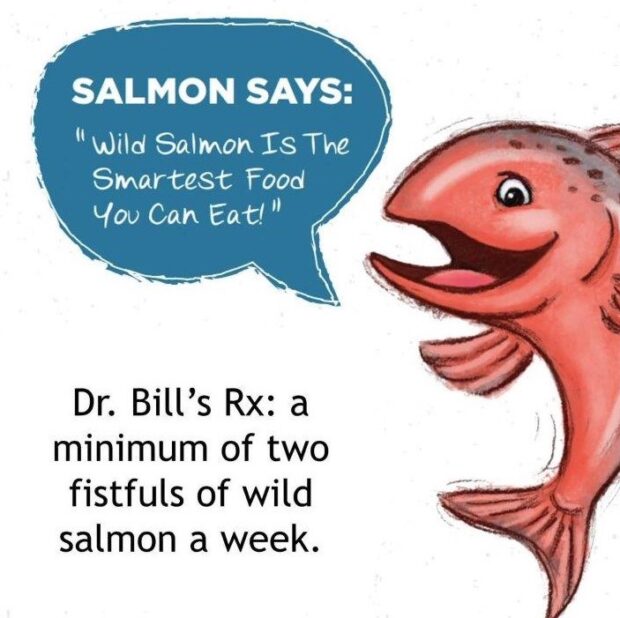
- Omega-3 Fats: DHA/EPA, 2000 mg
- Protein: 40 grams
- Vitamin D: 2000 IU
- Vitamin B12: 9 mcg
- Vitamin B6: 2 mg
- Selenium: 75 mcg
- Astaxanthin: 8 mg
- Choline: 190 mg
- Niacin: 16 mg
- Iodine: 100 mcg
- Carbs: 0
- Calories: 280
For more seafood information, see here.
- Click to open a list of my favorite grow foods. Print and post it in your kitchen as a handy reminder.
While most children tend to like the term “grow food” because they picture the food makes them stronger, smarter, and healthier, also try a motivating pitch that best fits your child’s favorite sport or activity: such as “football foods,” “soccer foods,” “ballet foods,” “pretty-hair foods,” and so on. When eating at a restaurant or at a party, simply say, “Grow foods first.”
A smart mom in my practice told me this: “My child is into sports, so I attach an action-related note, such as: ‘Eat your soccer balls’ on the little bag of cherry tomatoes.”
| Dr. Bill notes: Shape young tastes Parenting, in a nutshell, is giving your children the tools to succeed in life. When you first introduce solid foods, begin to shape young tastes by feeding your child primarily grow foods that gradually prompt the crave-centers in your child’s brain to not only like these foods but crave them. These cravings will continue as your child grows up and soon your child will be asking for more broccoli rather than detesting it. (See Shaping Young Tastes.) |
Begin the Day with a Brainy Breakfast
The third step of our action plan to help kids grow taller is to begin their day with a good breakfast.
If your family is like our family during morning rush-hour, sleepy kids and hurried parents seldom have time for long sit-down breakfasts. That’s the problem!
Solution: Feed your children a grow shake.
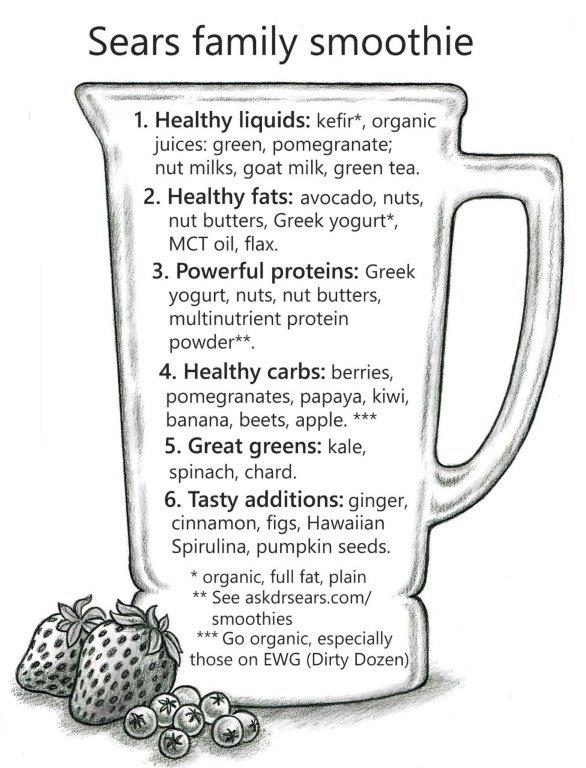
Smoothie recipe options.
The main ingredients of a grow-food meal for growing kids are:
- Protein: perks up the brain and is an important building block of growing body tissues, like the structural steel of buildings.
- Omega-3 fats: help build smart brain cells and help the child feel fuller longer.
- Fiber-filled carbs: provide a steady supply of fuel, but don’t “sugar spike.”
- Rich in grow minerals, such as calcium, iron, zinc, vitamins A, C, and D, and others.
| Dr. Bill’s grow tip: A crucial part of a smoothie is a high-quality protein mix. One of our favorites is Healthy Heights Grow Daily, which is specifically formulated for the nutritional needs of growing children. |
Protein Tips Every Parent Must Know
Here are the most common protein questions I get in my medical practice:
How much daily protein should my child eat?
Answer: One gram of protein per pound per day. For instance, a three year old who weighs around thirty pounds would need around thirty grams of protein a day. And, during growth spurts, add an extra five to fifteen grams per day. Since most children have erratic eating schedules, instead of a balanced meal shoot for a balanced week, so that over a week’s time your child would average around a gram of protein per pound per day.
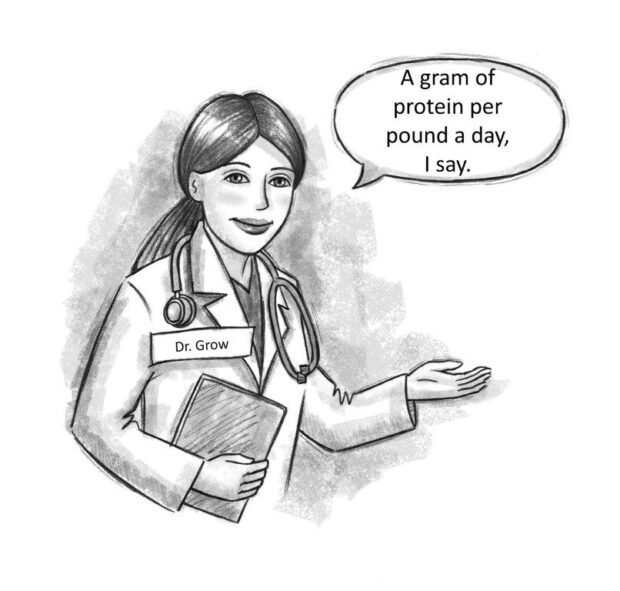
What is the best protein to help kids grow taller?
Answer: Our top protein pick as a grow food is whey protein, for these reasons:
- Whey protein is the prominent protein in mother’s milk. (Dr. Mother Nature is our most trusted “nutritionist.”)
- Whey protein is a good protein for muscle growth as it is rapidly absorbed by muscles.
- Whey protein has the highest biological value, meaning how well the body utilizes the protein for growth.
| Grow Foods that Pack the Most Protein |
|
At what ages is a right-protein diet most important for children?
Answer: When children are growing the most is when they need the most protein, which would be infancy and toddlerhood, periodic growth spurts during middle childhood, and during preteen and teen growth spurts.
On a side note, don’t be fooled by the misconception that you need less protein the older you get. In fact, for many individuals, including myself, it’s just the opposite. While infants and children need more protein for tissue growth, maintenance and repair, seniors go through a type of “second childhood” and often suffer from weak muscles and wrinkly skin from a protein insufficiency. So, my daily protein goal: eat like a child, a gram a day, to help maintain my muscle and other tissue maintenance.
Dr. Bill, why do you teach so much about protein as an important grow food?
Answer: There are five reasons:
- Protein perks up the brain by forming the building blocks of neurotransmitters, the biochemical language of the brain that carries messages from the brain throughout the body.
- Protein is a feel-good food. You’re more likely to have good gut feelings after a right-protein meal. Besides having a good gut feel, protein-rich foods have a good mouth feel.
- Protein is a fill-up food. I call it a “more-for-less food” – more nutritious, but less fattening. It’s harder to overeat on protein and fiber-rich foods because they fill you up faster than fiber-less carbs. Try this experiment: Next time you’re hungry, eat an egg. The following day, around the same time, eat a piece of white bread. You will notice that the protein-rich egg helps you feel fuller longer.
- Protein is good for weight and waist-management. Since the body uses more calories to digest protein than it uses to digest fat and carbs, protein speeds up your body’s metabolism, helping to keep you lean.
- Protein helps steady blood sugar. Because protein is digested slowly, your body doesn’t experience blood sugar highs and lows and blood sugar spikes like it would with a fiber-less carb meal.
Dr. Bill, I’m suffering from “supplement confusion.” What should I look for in choosing the best nutritional supplement for my family?
Answer: In choosing a smart nutritional supplement, say a protein powder, go through these steps:
- Show me the If I need it, but I don’t eat it, then I must take it. If your child does not eat a gram per pound a day, he probably needs a protein powder supplement.
- Show me the Any nutritional supplement that has been scientifically studied will be proud to show on their website a section on “clinical studies.” For example, google “growth, protein supplements” and see which ones show a section on their website about their clinical studies.
- Show me it makes Protein is a top building block for child growth, and if your family does not regularly eat enough, then a protein powder supplement makes sense.
- Show me the Where does it come from? Again, whey protein wins.
Raise a Grow-Food Grazer
The fourth step to help kids grow taller is to raise them to be a grow-food grazer.
Big meals can cause big biochemical digestion problems in the gut. Many children are more “wolfers” than grazers. During my decades of experience in medical practice of transforming gorgers into grazers, I have noticed that grazers tend to grow better, be leaner, are more satisfied and less hungry, less moody, enjoy more good gut feelings, and are generally healthier.
Dr. Poo is Required Reading for You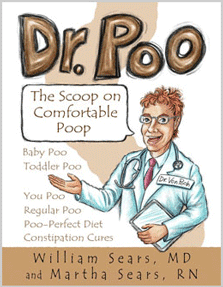
For a fun and informative read on why grazing is good for your whole family, especially children, and how to raise a grazer and become a grazer at any age, enjoy our booklet Dr. Poo: The Scoop on Comfortable Poop (see AskDrSears.com/DrPoo).
Dr. Bill’s Rule of 2’s for Healthy Grow-Food Grazing
- Eat twice as often.
- Eat half as much.
- Chew twice as long.
- Take twice the time to dine.
Teach your children the “chew-chew times two,” which allows the food to remain in their mouth longer and gives time for the oral digestive enzymes to click in and prepare the rest of the intestinal tract for more comfortable digestion.
Move More, Sit Less, Grow Better
Your final step in the action plan to help kids grow taller is to have them move more and sit less.
Not only are many children not enjoying optimal growth because of NDD (nutrition deficit disorder), many children are not enjoying their best growth because of MDD – movement deficit disorder. Like many adults, children are also suffering from “the sitting disease.” Witness the constant movement of a wiggly-squiggly toddler; the body of a growing child is meant to move. Why? Because movement gets your blood flowing, a crucial part of cardiovascular health. We’ll discuss this more in-depth later on.
| Dr. Bill notes: Sit and stew is bad for you! |
We doctors have learned many lessons – for health and for life – from the recent pandemic, especially lessons for children’s health. Specifically we learned:
- Lock down doesn’t mean sit down.
- Sit and stew is bad for you!
During the past few years one of the most common “prescriptions” I have been writing is:
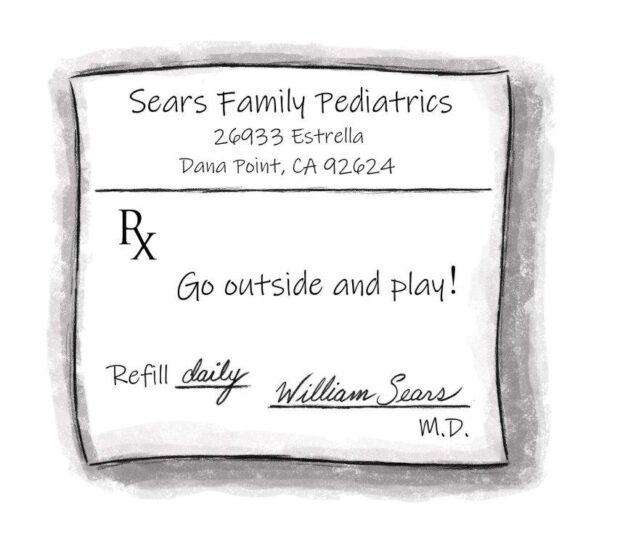
Growing a healthy child is like growing a garden. Your child’s body/brain is the greatest garden ever grown. What are the three things you need to do to grow a healthy garden? You need to feed and fertilize the plants (grow foods), water the plants (movement), and prune the plants and keep out the weeds (keep fit, “don’t worry, be happy,” and avoid toxic thoughts).
When you don’t feed, fertilize, and prune a garden, the plants “wither.” Sorry to say, many kids nowadays are “withering”:
- Type 2 diabetes has tripled in recent years, especially in children.
- Depression and anxiety are now at the highest levels, and at younger ages.
- Obesity is skyrocketing.
- Dementia is occurring at a younger age.
- The medical term “adult-onset disease” is no longer used because these diseases are now occurring at younger ages.
“Dr. Bill, how do I explain to my kids your two mantras: ‘Go outside and play,’ and ‘Sit and stew’ is bad for you?”
Kids love stories, so let’s begin:
“Your body and brain are like beautiful gardens. Let’s talk about how you can help these gardens grow. Remember, every organ in your body is only as healthy as the blood flow to it.”
| Dr. Bill notes: Better blood flow, better body/brain. |
Meanwhile, the kids are thinking “That makes sense!” I continue: “You just learned how to eat more ‘grow food nutrients.’ And, here is a very important message: Your blood vessels – the nutrient-delivery highways throughout your body-brain – deliver these nutrients to all of your organs. So, eating more grow foods and making healthier blood vessel-delivery systems are partners in helping you grow!”
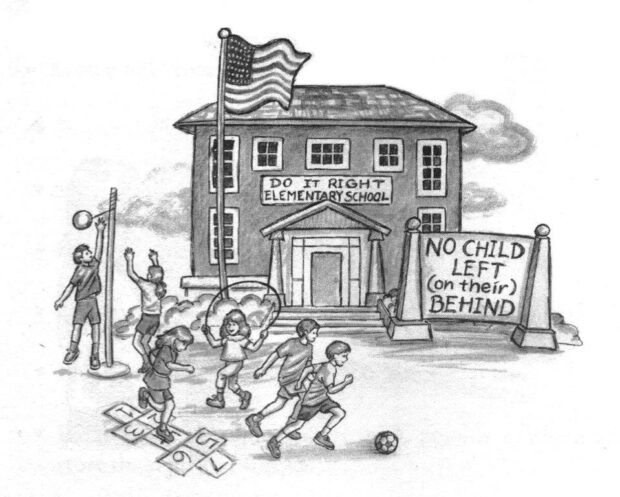
During my garden-growth talks, a favorite take-home tip that kids like is the character VEG (kid-speak for vascular endothelial growth factor), a natural biochemical that helps vessels grow stronger.
| Dr. Bill notes: Movement makes more VEG. |
Kids love my “sticky stuff” analogy for junk food. I recently gave this talk to a first-grade class and a mother told me this story: “My six-year-old daughter loved your ‘sticky stuff’ talk! The next day my husband piled our kids into the van and took them for fast food. As they pulled into the drive-thru, our six-year-old scolded her father: ‘Daddy, we can’t put sticky stuff in our mouth because we’ll get sticky stuff in our blood vessels, and our bodies won’t grow nice and our brains won’t grow smart!’”

Movement Makes Your Own Medicines
Ready for my favorite benefit of movement? Brisk movement causes blood to flow faster over the surface of the endothelium (the lining of your blood vessels). The endothelium is your body’s largest endocrine organ. If you open all your blood vessels and spread them out flat, your endothelium would cover the surface area of several tennis courts. Each cell of the endothelium is its own endocrine organ, filled with “microscopic medicine bottles” that release health-promoting substances into the bloodstream at just the right time, in the right amount, with no harmful side effects – and they’re free. The fast-moving blood creates an energy field called shear force, which releases a natural biochemical called nitric oxide. Nitric oxide (NO) acts as a biochemical key to open your pharmacy and dispense the medicines you need.
One day shortly after a visit with my movement-mentor, Nobel laureate Dr. Lou Ignarro, I was watering my actual garden when I had a transformative thought: That’s what movement does! It waters the gardens of my body and brain. Now, when I’m teaching kids about health, they love my garden analogy:
- Every organ in your body is like a garden: the better you feed, fertilize, and irrigate it, the better it thrives.
- An organ is only as healthy as the blood flow to it.
- Movement widens blood vessels. Like using a larger garden hose, it increases the volume of blood flow.
- The more you move, the more personal medicines you make, and the more nutrients you deliver. It’s like feeding your garden more water and fertilizer.
| Life Lessons from Leaves Much of my learning was literally on the job while traveling, lecturing, and learning from my mentors. On a lecture trip to Singapore, Martha and I visited one of the world’s most technologically modern gardens, called Gardens by the Bay, which locals dub “the billion-dollar garden.” Even though some of the world’s greatest gardeners had constructed this masterpiece and maintained the plants and trees with enough water, sunlight, and natural fertilizer, some plants still withered. What plant-growth factor was missing? Movement! In nature, wind moves the leaves and branches, and this movement naturally draws nourishment into the roots. After the gardeners installed fans to move the leaves and branches, the plants, trees, and their roots flourished. Our take-home tip: If we don’t move enough, we wither. We go outside and play, we flourish. |
During my adventures in making brain health my hobby, I noticed how much better my body felt and how much better my brain thought during a good old walk in the park. As a show-me-the-science doctor, I had to find out why. My quest for an answer took me to calling Harvard neuroscientist Dr. Eva Selhub, co-author of Your Brain on Nature. I asked her: “Eva, can you simply summarize the body-brain effects of movement in nature?” Her reply: “Green exercise is like exercise squared.”
My message to all you “gardeners” who want to help your kids grow taller and healthier: make grow-food health your family hobby.
Dr. Bill’s important note to readers. While the information presented here is based on my over fifty years of experience in medical practice, learning from my many trusted mentors in health and nutrition, and the hundreds of scientific references listed in the following resources, your family may have special metabolic or medical needs that require tweaking of our grow-food health plan. Before starting any health plan, be sure to discuss the details with your healthcare provider.
Additional Research on How to Help Kids Grow Taller
Want to learn more about how to help kids grow?
To delve deeper into the science behind grow foods and grow movement, see our following resources:
- The Dr. Sears T5 Wellness Plan (best exercises for muscle and bone growth).
- The Healthy Brain Book (especially the section on how quality sleep helps growth).
- Endothelial Pharmacy. This seven-minute video will be a riveting watch for your whole family about how your endothelium and movement help your body make its own medicines.
- Why Movement is the Best Medicine.
- Your Brain on Nature by Dr. Eva Selhub


